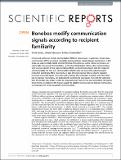Files in this item
Bonobos modify communication signals according to recipient familiarity
Item metadata
| dc.contributor.author | Genty, Emilie | |
| dc.contributor.author | Neumann, Christof | |
| dc.contributor.author | Zuberbuehler, Klaus | |
| dc.date.accessioned | 2016-03-25T16:30:04Z | |
| dc.date.available | 2016-03-25T16:30:04Z | |
| dc.date.issued | 2015-11-10 | |
| dc.identifier | 241308703 | |
| dc.identifier | 08434385-2cc3-41c0-9cc6-2b4512c83ad6 | |
| dc.identifier | 000364385000001 | |
| dc.identifier | 84946962994 | |
| dc.identifier | 000364385000001 | |
| dc.identifier.citation | Genty , E , Neumann , C & Zuberbuehler , K 2015 , ' Bonobos modify communication signals according to recipient familiarity ' , Scientific Reports , vol. 5 , 16442 , pp. 1-10 . https://doi.org/10.1038/srep16442 | en |
| dc.identifier.issn | 2045-2322 | |
| dc.identifier.other | ORCID: /0000-0001-8378-088X/work/64360674 | |
| dc.identifier.uri | https://hdl.handle.net/10023/8491 | |
| dc.description | This project has received funding from the European Union’s Seventh Framework Programme for research, technological development and demonstration under grant agreement no 283871. | en |
| dc.description.abstract | Human and nonhuman primate communication differs in various ways. In particular, humans base communicative efforts on mutual knowledge and conventions shared between interlocutors. In this study, we experimentally tested whether bonobos (Pan paniscus), a close relative to humans, are able to take into account the familiarity, i.e. the shared interaction history, when communicating with a human partner. In five experimental conditions we found that subjects took the recipients' attentional state and their own communicative effectiveness into account by adjusting signal production accordingly. More importantly, in case of communicative failure, subjects repeated previously successful signals more often with a familiar than unfamiliar recipient, with whom they had no previous interactions, and elaborated by switching to new signals more with the unfamiliar than the familiar one, similar to what has previously been found in two year-old children. We discuss these findings in relation to the human capacity to establish common ground between interlocutors, a crucial aspect of human cooperative communication. | |
| dc.format.extent | 10 | |
| dc.format.extent | 464844 | |
| dc.language.iso | eng | |
| dc.relation.ispartof | Scientific Reports | en |
| dc.subject | Chimpanzees pan-troglodytes | en |
| dc.subject | Orangutans Pongo-pygmaeus | en |
| dc.subject | Gestural communication | en |
| dc.subject | Revision behaviors | en |
| dc.subject | Attentional status | en |
| dc.subject | Visual-attention | en |
| dc.subject | Differential use | en |
| dc.subject | Olive baboons | en |
| dc.subject | Papio-anubis | en |
| dc.subject | Language | en |
| dc.subject | BF Psychology | en |
| dc.subject | QH301 Biology | en |
| dc.subject | NDAS | en |
| dc.subject.lcc | BF | en |
| dc.subject.lcc | QH301 | en |
| dc.title | Bonobos modify communication signals according to recipient familiarity | en |
| dc.type | Journal article | en |
| dc.contributor.institution | University of St Andrews. School of Psychology and Neuroscience | en |
| dc.contributor.institution | University of St Andrews. Institute of Behavioural and Neural Sciences | en |
| dc.contributor.institution | University of St Andrews. Centre for Social Learning & Cognitive Evolution | en |
| dc.identifier.doi | https://doi.org/10.1038/srep16442 | |
| dc.description.status | Peer reviewed | en |
This item appears in the following Collection(s)
Items in the St Andrews Research Repository are protected by copyright, with all rights reserved, unless otherwise indicated.

